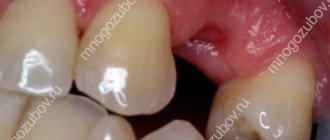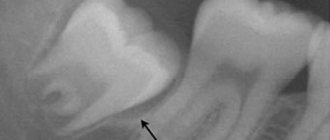31.10.2019
For many, a visit to the dentist is something scary and terrifying. This is true, because dental treatment is often perceived as an execution. In this article we will tell you what to do if your gums become swollen after tooth extraction.
Why is my cheek swollen after tooth extraction?
In most cases, minor swelling after tooth extraction is absolutely normal. This should not be a cause for concern if the swelling lasts 1-3 days.
Swollen cheek after tooth extraction:
- This can last longer if a molar is removed whose roots are intertwined with other teeth. Which often happens with the very last molars.
- That is why it is necessary to be attentive to your health. Swelling may persist for longer than one or two days if additional surgical interventions were used during tooth extraction.
- Very often the doctor is not able to pull out the entire tooth. Crushing or cutting of the gums may be used.
Contraindicated actions for swelling:
- Under no circumstances should you heat the swollen area, or touch the wound with your hands and tongue;
- rinsing on the first day after tooth extraction is not recommended, as it can wash away the blood clot that protects the socket from infections. In the future, you can rinse your mouth with antiseptic solutions - miramistin, furatsilin, or decoctions of chamomile, sage;
- the first two to three hours after the removal operation, you should refrain from smoking, drinking and eating;
- Until the wound is completely healed, you should not consume solid food, hot and carbonated drinks, or alcohol.
If you follow these simple rules, the swelling will go away quickly enough and there will be no need to visit the dentist.
My cheek is swollen after tooth extraction, what should I do?
Many patients strive to speed up tooth healing, so they ask questions about how this can be done. Some patients, contrary to the doctor’s advice, try to reduce pain and speed up recovery.
My cheek is swollen after tooth extraction, what to do:
- However, not all of them know how to do it correctly. Use a variety of rinsing solutions. These may be antiseptics such as Miramistin and Chlorhexidine.
- Yes, these solutions are very effective, but only if there was surgery on the gum, or a hole was left during tooth treatment, which the doctor will fill next time.
- That is, almost all rinses need to be performed only if they were prescribed by a doctor. After tooth extraction, a blood clot forms over the course of several hours.
- It is this that promotes good healing and prevents pathogenic microorganisms that live in sufficient quantities in the mouth from entering the deep layers. That is why such rinses can cause a blood clot to be removed from the socket. After this, severe bleeding and even greater swelling of the gums may begin.
When to see a doctor
If you have followed all the rules, carried out all the procedures aimed at reducing swelling, and your condition continues to worsen, then this is a sure sign that you need to urgently consult a dentist. Immediate medical attention is required if:
- the next day the swelling increased, and the pain did not decrease;
- the temperature has risen, general health has worsened;
- opening the mouth is accompanied by painful sensations, and the smell of rotting from the hole is felt.
All these symptoms should prompt an immediate visit to the dentist to avoid serious consequences.
Does the cheek swell after wisdom tooth removal?
Yes, usually it is after the removal of this tooth that swelling occurs. There's no need to worry.
Does the cheek swell after wisdom tooth removal, what to do:
- Do not use rinses after tooth extraction. You can relieve pain and reduce swelling with a cold compress. To do this, you need to take a piece of frozen meat or ice, wrap it in cloth, and apply it to the sore cheek.
- It is advisable to apply such compresses approximately once every 30 minutes for 3-4 minutes. This will remove swelling and reduce pain. In addition, you can resort to salt compresses.
- To do this, take exclusively sterile gauze, cut it into small pieces, and fold it into squares. It is necessary to moisten each piece in a solution, which is prepared by dissolving a teaspoon of salt and 10 g of soda in a liter of water. This is a kind of antiseptic solution that helps remove suppuration and relieve pain after tooth extraction.
How to remove swelling of the cheeks and gums
If the tumor does not cause particular concern, then it is a natural phenomenon after tooth extraction.
There are ways to relieve pain and reduce swelling, as long as it is not harmful to health.
- It is necessary to apply cooling compresses to the inflamed cheek several times during the day, this can be a bottle of cold water, ice in a cloth, a damp towel, which should be kept for twenty minutes, periodically cooling it in cold water. You will immediately feel relief and notice how the tumor decreases in size.
- People with high blood pressure are more susceptible to post-operative swelling. They are recommended to take sedatives and blood pressure-normalizing medications after tooth extraction.
- Conventional anti-edema products can relieve swelling well - gels, creams, ointments that can be applied to the outside of the cheek.
- To relieve pain, which is inevitable after complex removals, you can take a painkiller (except aspirin) or an anti-inflammatory drug and lie down to rest.
After the removal of a wisdom tooth, my cheek swells, what should I do?
After tooth extraction, it is advisable not to consume food or water at all for 4 hours. It is allowed to drink ordinary water without gas, but so that it does not get into the hole and wash out the formed blood clot from there.
After the removal of a wise tooth, the cheek swells:
- For several days, on the advice of your dentist, it is best to avoid spicy, hot and very cold foods. In addition, avoid hard foods that require chewing and straining your jaw for a long time.
- When wisdom teeth are removed, swelling and pain may be observed when the jaw is opened wide and chewing movements are performed. Therefore, avoid solid foods, nuts, and tough meats.
- During these few days, it is best to switch to a kind of soft diet. Eat exclusively porridges and soups, the temperature of which is approximately 20-25 degrees.
Exostosis, fistula or beneficial plaque: types of growths after removal
Tooth extraction is always traumatic. The doctor extracts the tooth, damaging soft and bone tissues and breaking blood vessels. After the tooth is extracted, the wound fills with blood, which coagulates into a clot. The naturally formed blood clot closes the hole, protecting it from bacteria and stimulating regeneration processes.
With the correct course of events, the hole gradually overgrows, closes, and ceases to disturb the patient. But sometimes a formation forms at the site of removal - on the hole itself or nearby. Possible options:
- white dense coating;
- cyst;
- fistula;
- exostosis.
Each formation has its own nature and reasons for its appearance. Some require treatment, others are beneficial and go away on their own.
White plaque or growth after tooth extraction
During the first hours after removal, bleeding stops in the hole and a dark blood clot appears. After a couple of days, a white coating is noticeable on the clot. Externally similar to purulent discharge, it frightens many patients. But this is the next stage of healing - fibrin protein fibers.
Fibrin performs several functions at once:
- accelerates tissue regeneration, including bone;
- helps reduce the size of the hole;
- protects the wound from bacteria and pathogenic microflora;
- helps the blood clot dissolve.
The plaque often acquires a dense, hard structure, and patients mistake the fibrinous film for a growth. White growth on the tooth socket after extraction is a natural healing process and should not be a cause for concern.
Cyst or fistula after tooth extraction
The cyst and fistula only indirectly resemble a white growth. But often patients describe the pathological condition this way. The reason is the filling of the formation with liquid, pus, which gives the lump a whitish tint.
A fistula is a channel through which purulent contents are removed from the hole. It is located near the site of the extracted tooth. The tissues around the formation are inflamed.
A cyst is a cavity or lump that occurs when tissue is damaged during surgery. It has walls and contents, and stands out strongly above the surface of the gum. Causes pain.
Both a cyst and a fistula are pathological formations that require removal. Externally, patients define them as growths in the area of tooth extraction.
If there are no visible manifestations, indirect signs of ill health will be:
- a feeling of heaviness and pressure in the area of the hole;
- soft tissue swelling;
- jaw pain;
- heat;
- discomfort when eating;
- smell from the mouth;
- burning gums;
- individual signs of intoxication of the body.
If you have unpleasant symptoms, you should consult a doctor to determine the type of pathology and its treatment. The main methods are drug therapy or surgical removal of the formation. The dentist chooses the method after assessing the clinical situation.
Exostosis - bone growth after tooth extraction
Exostosis - bumps, spines, growths on the gums that arise due to hereditary factors or after complex tooth extraction. The cause of protruding ridges is improperly fused bone, the consequences of displacement of bone tissue due to careless work of the surgeon.
The pathology looks unaesthetic, but does not cause much discomfort. If the formation is significant in size, it can put pressure on the bone and nearby teeth and become a contraindication for dental implantation.
Removal of exostosis is carried out surgically. After anesthesia, the doctor makes an incision into the soft tissue, saws off the growth, straightens the bone, and applies sutures. Healing occurs quickly and the formation does not reappear.
Other causes of gum growth
Lumps and growths on the gums appear after removal and for other reasons:
- infectious processes that began due to non-compliance with the surgeon’s recommendations after removal;
- allergic reaction to anesthetic drugs;
- mechanical damage - due to careless removal.
Sometimes a growth occurs at the site where the anesthetic injection was given. Such a hematoma resolves on its own in 2-3 days.
Other lumps require consultation with a dentist.
My cheek is very swollen after tooth extraction, what should I do?
Sometimes after complex operations, doctors generally prescribe foods that you can drink rather than chew. That is, almost all chewing movements are excluded. You can resort to a trick and grind all the soups in a blender.
You can prepare chicken or meat puree in the same way. But most often such manipulations are required if the wisdom tooth was removed with an incision in the jaw and crushing of the gums. In other cases, swelling and swelling usually resolve within 2 days.
My cheek is very swollen after tooth extraction, what to do:
- In what cases is it necessary to consult a doctor? If every day the swelling does not subside, but rather grows. This means that pathogenic microorganisms enter the wound and grow. That is, purulent microorganisms grow in the hole, and along with this, bad breath may occur.
- This indicates an inflammatory process, suppuration inside the wound. You cannot delay; you must immediately consult a doctor. They may prescribe a second operation, with dissection of the gums, cleaning of the tissue and installation of drainage.
- However, now in most cases, to alleviate suffering and for the patient to recover faster and return to normal life after the removal of large molars, 1-2 sutures are applied. This promotes rapid tissue healing and reduction of swelling in just a few hours.
Symptoms
The initial stage of the pathology practically does not manifest itself. Symptoms generally have a vague picture, which is why patients rarely see a doctor in a timely manner. But as the condition worsens, the following symptoms appear:
- growths with a pronounced convex shape appear on the tissues; the structure can be embossed or smooth;
- there is a feeling of a foreign object in the mouth;
- pain appears, sometimes quite severe;
- partial jaw dysfunction is observed;
- the shade of the mucous membrane changes to bright;
- capillary obstruction appears in the area of the growth.











